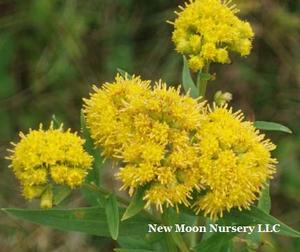Printed at http://www.newmoonnursery.com/index.cfm/
Solidago graminifolia
Grass-leaved goldenrod
Native to North America
FIRST IMPRESSIONS: Solidago graminifolia is an upright perennial wildflower. Leaves are alternate, linear and grass-like. From late summer into fall stems are terminated with flat topped yellow flower clusters. Plants are tough, vigorous and adaptable, prospering in sunny or partly shaded dry or moist sites.
HABITAT & HARDINESS: Solidago graminifolia occurs through most of North America except for Florida, Georgia, Arkansas, Nebraska, Kansas and several western states.
Indigenous plants occur in moist Blackland prairies, borders of marshes, calcareous seeps, meadows, fens, abandoned fields, lake shores and ditches. This species usually occurs in moist or wet habitats.
Plants are hardy from USDA Zones 3-9.
PLANT DESCRIPTION: Solidago graminifolia is a bushy clumping perennial. Lower stems are unbranched but leafy branches occur on the upper part of the plant. Stems are mostly smooth with thin rows of fine white hairs.
Leaves are alternate and linear or narrowly lanceolate. They average 1.5-4” long and less than ½” wide. The blades are sharply pointed and sessile. The leaf surface and margin usually have short scattered hairs.
From late summer to fall, clusters of small flower heads form at the tip of the central stalks and on the upper lateral stems. The entire corymb-like inflorescence is flat topped or occasionally rounded.
Each flowerhead is 1/8” across and consists of 20-35 disc and ray florets.
In autumn the florets mature into tiny pubescent achenes crowned by tufts of hair. The achenes are distributed by wind and offsets form from the underground rhizomes.
Plants grow 2-4’ tall with 1-2’ spread.
CULTURAL & MAINTENANCE NEEDS: Solidago graminifolia thrives in sunny sites with moist soil. Plants tolerate part shade, some drought and sandy, loamy, clay or gravelly soils.
This species is relatively pest free. Plants often spread aggressively in ideal moist sunny sites.
LANDSCAPE USES: This is a good choice for a Wildlife Garden or Meadow. Plants are also used as Butterfly Nectar Plants or as part of a Grouping or Mass Planting. Solidago graminifolia has Showy Blooms and can be used in Cottage Gardens, Water-wise Landscapes, Low Maintenance Plantings, Perennial Borders, Roadsides and Restoration Projects.
COMPANION & UNDERSTUDY PLANTS: Try pairing Solidago graminifolia with Aster laevis, Allium cernuum, Carex bicknellii, Eupatorium colestinum, Liatris aspera, Monarda punctata, Heliopsis helianthoides or Sporobolus heterolepis.
If a substitute is needed, Solidago rigida or Solidago speciosa are goldenrods with similar cultural needs.
TRIVIA: Native bees, wasps, butterflies, moths, beetles and pollinating flies seek nectar and pollen from the flowers. Plants host the caterpillars of several moth species. Seed are eaten by songbirds like Eastern Goldfinch and Swamp Sparrow and occasionally by game birds. White-tailed Deer and Cottontail Rabbits graze on the foliage.
Solidago graminifolia can be differentiated from most other Solidago spp. due to the narrow leaves, flat topped clusters of smaller and more numerous flower heads and bushy habit.
Solidago graminifolia most closely resembles Solidago gymnospermoides. S. graminifolia can be distinguished from this look-alike by its multiple conspicuous leaf veins, pubescent stems, more disc and ray florets per head and a preference for wetter habitats. S. gymnospermoides has only 1 conspicuous leaf vein, smooth stems, fewer disc and ray florets and a more branched bushier habit.
This species is also known as Euthamia graminifolia.
Height:
2-4 ftSpread:
1-2 ftSpacing:
2 ftUSDA Hardiness Zone:
3-9Bloom Color:
YellowSolidago graminifolia Characteristics
Attracts Wildlife
- Butterflies
- Songbirds
- Pollinators
Attributes
- Drought Tolerant
- Dried Flower
- Cut Flower
- Clay Soil
- Rock Garden
- Naturalizing
- East-Coast Native
Exposure
- Full Sun to Partial Shade
Flowering Months
- October
- September
Foliage Color
- Green
Growth Rate
- Medium
Juglans nigra Tolerance (Black Walnut)
- Yes
Season of Interest (Foliage)
- Fall
- Summer
- Spring
Soil Moisture Preference
- Moist to Wet
Interesting Notes:
For more information on this plant, visit the USDA PLANTS Database: http://plants.usda.gov/java/profile?symbol=EUGRG

